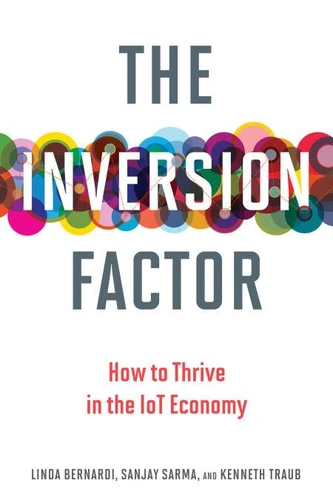The Inversion Factor. How to Thrive in the IoT Economy
Par : , ,Formats :
Disponible dans votre compte client Decitre ou Furet du Nord dès validation de votre commande. Le format ePub protégé est :
- Compatible avec une lecture sur My Vivlio (smartphone, tablette, ordinateur)
- Compatible avec une lecture sur liseuses Vivlio
- Pour les liseuses autres que Vivlio, vous devez utiliser le logiciel Adobe Digital Edition. Non compatible avec la lecture sur les liseuses Kindle, Remarkable et Sony
- Non compatible avec un achat hors France métropolitaine
 , qui est-ce ?
, qui est-ce ?Notre partenaire de plateforme de lecture numérique où vous retrouverez l'ensemble de vos ebooks gratuitement
Pour en savoir plus sur nos ebooks, consultez notre aide en ligne ici
- Nombre de pages240
- FormatePub
- ISBN978-0-262-34494-4
- EAN9780262344944
- Date de parution20/10/2017
- Protection num.Adobe DRM
- Taille2 Mo
- Infos supplémentairesepub
- ÉditeurThe MIT Press
Résumé
Why companies need to move away from a "product first" orientation to pursuing innovation based on customer need. In the past, companies found success with a product-first orientation; they made a thing that did a thing. The Inversion Factor explains why the companies of today and tomorrow will have to abandon the product-first orientation. Rather than asking "How do the products we make meet customer needs?" companies should ask "How can technology help us reimagine and fill a need?" Zipcar, for example, instead of developing another vehicle for moving people from point A to point B, reimagined how people interacted with vehicles.
Zipcar inverted the traditional car company mission. The authors explain how the introduction of "smart" objects connected by the Internet of Things signals fundamental changes for business. The IoT, where real and digital coexist, is powering new ways to meet human needs. Companies that know this include giants like Amazon, Airbnb, Uber, Google, Tesla, and Apple, as well as less famous companies like Tile, Visenti, and Augury.
The Inversion Factor offers a roadmap for businesses that want to follow in their footsteps. The authors chart the evolution of three IoTs-the Internet of Things (devices connected to the Internet), the Intelligence of Things (devices that host software applications), and the Innovation of Things (devices that become experiences). Finally, they offer a blueprint for businesses making the transition to inversion and interviews with leaders of major companies and game-changing startups.
Zipcar inverted the traditional car company mission. The authors explain how the introduction of "smart" objects connected by the Internet of Things signals fundamental changes for business. The IoT, where real and digital coexist, is powering new ways to meet human needs. Companies that know this include giants like Amazon, Airbnb, Uber, Google, Tesla, and Apple, as well as less famous companies like Tile, Visenti, and Augury.
The Inversion Factor offers a roadmap for businesses that want to follow in their footsteps. The authors chart the evolution of three IoTs-the Internet of Things (devices connected to the Internet), the Intelligence of Things (devices that host software applications), and the Innovation of Things (devices that become experiences). Finally, they offer a blueprint for businesses making the transition to inversion and interviews with leaders of major companies and game-changing startups.
Why companies need to move away from a "product first" orientation to pursuing innovation based on customer need. In the past, companies found success with a product-first orientation; they made a thing that did a thing. The Inversion Factor explains why the companies of today and tomorrow will have to abandon the product-first orientation. Rather than asking "How do the products we make meet customer needs?" companies should ask "How can technology help us reimagine and fill a need?" Zipcar, for example, instead of developing another vehicle for moving people from point A to point B, reimagined how people interacted with vehicles.
Zipcar inverted the traditional car company mission. The authors explain how the introduction of "smart" objects connected by the Internet of Things signals fundamental changes for business. The IoT, where real and digital coexist, is powering new ways to meet human needs. Companies that know this include giants like Amazon, Airbnb, Uber, Google, Tesla, and Apple, as well as less famous companies like Tile, Visenti, and Augury.
The Inversion Factor offers a roadmap for businesses that want to follow in their footsteps. The authors chart the evolution of three IoTs-the Internet of Things (devices connected to the Internet), the Intelligence of Things (devices that host software applications), and the Innovation of Things (devices that become experiences). Finally, they offer a blueprint for businesses making the transition to inversion and interviews with leaders of major companies and game-changing startups.
Zipcar inverted the traditional car company mission. The authors explain how the introduction of "smart" objects connected by the Internet of Things signals fundamental changes for business. The IoT, where real and digital coexist, is powering new ways to meet human needs. Companies that know this include giants like Amazon, Airbnb, Uber, Google, Tesla, and Apple, as well as less famous companies like Tile, Visenti, and Augury.
The Inversion Factor offers a roadmap for businesses that want to follow in their footsteps. The authors chart the evolution of three IoTs-the Internet of Things (devices connected to the Internet), the Intelligence of Things (devices that host software applications), and the Innovation of Things (devices that become experiences). Finally, they offer a blueprint for businesses making the transition to inversion and interviews with leaders of major companies and game-changing startups.



